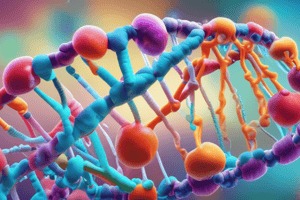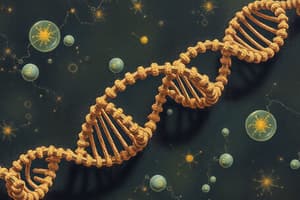Podcast
Questions and Answers
What is the primary function of DNA?
What is the primary function of DNA?
- To transport nutrients within the cell
- To regulate gene expression
- To store and transmit genetic information (correct)
- To synthesize proteins
Which of the following statements about RNA is correct?
Which of the following statements about RNA is correct?
- RNA plays various roles in cellular processes, including protein synthesis (correct)
- RNA is responsible for the storage of genetic information
- RNA is a double-stranded molecule like DNA
- RNA is the primary genetic material in prokaryotic organisms
What is the process by which RNA molecules are generated from DNA templates?
What is the process by which RNA molecules are generated from DNA templates?
- Recombination
- Transcription (correct)
- Replication
- Translation
Which of the following is the correct order of the three stages of DNA replication?
Which of the following is the correct order of the three stages of DNA replication?
What is the primary purpose of DNA replication?
What is the primary purpose of DNA replication?
What is the primary function of DNA?
What is the primary function of DNA?
Which of the following best describes the structure of DNA?
Which of the following best describes the structure of DNA?
Which of the following nitrogenous bases is not found in DNA?
Which of the following nitrogenous bases is not found in DNA?
What is the primary function of RNA?
What is the primary function of RNA?
Which of the following best describes the process of transcription?
Which of the following best describes the process of transcription?
Which of the following is not a component of a nucleotide in DNA?
Which of the following is not a component of a nucleotide in DNA?
Flashcards are hidden until you start studying
Study Notes
Nucleic Acids: Structure, Function, Transcription, and Replication
Nucleic acids play a central role in the storage, transmission, and expression of genetic information within living organisms. There are two types of nucleic acids: deoxyribonucleic acid (DNA) and ribonucleic acid (RNA).
DNA Structure
Deoxyribonucleic acid (DNA) is a long polymer of nucleotides, which consist of a sugar molecule called deoxyribose, a phosphate group, and one of four nitrogenous bases: adenine (A), guanine (G), cytosine (C), or thymine (T). These bases pair together through hydrogen bonding: A pairs with T, and C pairs with G. This base pairing forms a double helix structure held together by hydrogen bonds.
RNA Function
Ribonucleic acid (RNA) also consists of nucleotides, but it uses a different sugar molecule: ribose instead of deoxyribose. Like DNA, RNA can have either adenine (A), guanine (G), cytosine (C), or uracil (U) as its nitrogenous bases. However, unlike DNA, RNA typically has a single strand structure rather than a double helix. Single-stranded RNA can fold into complex structures with functional roles in translation, nuclear transport, and other processes.
Transcription
Transcription is the process by which information encoded in DNA is used to produce RNA copies of genes, known as messenger RNA (mRNA). This process involves the enzyme RNA polymerase, which reads the genetic code of DNA and synthesizes a complementary RNA strand. Transcription occurs in three steps: initiation, elongation, and termination.
Replication
Replication is the process by which DNA molecules are copied to produce two identical DNA molecules. This process is crucial for cell division and the transmission of genetic information to offspring. Replication occurs in three stages: initiation, elongation, and termination.
In summary, nucleic acids are essential molecules that store, transmit, and express genetic information in living organisms. They comprise DNA and RNA, which have distinct structures and functions. DNA is a double-stranded molecule that serves as the genetic material, while RNA is a single-stranded molecule that plays various roles in cellular processes. Transcription is the process by which RNA copies of genes are generated, and replication is the process by which DNA molecules are copied to ensure the continuity of genetic information.
Studying That Suits You
Use AI to generate personalized quizzes and flashcards to suit your learning preferences.




